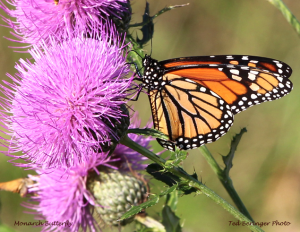Federal pollinator plan needs 1 billion milkweed plants for monarch butterflies
By Josephine Marcotty
Minneapolis Star Tribune
Starting as soon as this fall, America’s midsection could begin to look strikingly different to a monarch butterfly fluttering south for the winter.
Oceans of corn would be dotted with islands of native plants. Homeowners would have fewer lawns – and a lot less mowing. Roadsides would grow thick with grasses and flowers. And more than a billion unruly milkweed plants would pop up along a 200-mile-wide corridor along I-35 from Minnesota to Kansas to Texas.
That’s the ambitious vision buried in a national pollinator plan released by the White House – an epic attempt to save the gaudy symbol of the prairie from its steady slide toward the Endangered Species list. The key is milkweed, the one and only food source for monarch caterpillars, which has all but disappeared from Midwestern landscapes, thanks largely to GMO crops and the widespread use of Roundup.
But if it succeeds, the plan would rescue pollinators considered vital to a healthy environment, and in five years the number of monarchs that travel 3,000 miles every year from the Midwest to the mountains of Mexico and then back again, would increase by nearly tenfold.
“We are going to get the most bang for our buck by concentrating on the prairie corridor,” said Karen Oberhauser, a University of Minnesota professor and one of two key scientists advising federal agencies on the monarch plan.
And monarchs won’t be the only ones to benefit.
“It’s a flagship species for a lot of other critters that will enjoy that habitat,” said Tom Melius, director of the Midwest region for the U.S. Fish and Wildlife Service, which is leading the monarch restoration plan. That includes grassland birds, which are also disappearing from the landscape, and pollinators of all kinds, he said.
Monarchs earned a place in the White House pollinator plan in part because they are wildly popular, and because they have an extraordinary migration that makes it easy to measure their shocking decline.
In January this year, monarchs covered about 2.8 acres of trees in Mexico, their primary overwintering site, where they droop from the branches in great fluttering clusters through the cold months.
That’s better than the all-time low of 33 million butterflies spread over 1.6 acres, in 2014. But their numbers have crashed since the mid-1990s, when they covered 30 to 40 acres of acres of trees every winter.
The trend is so alarming that last year a number of environmental groups petitioned the U.S. Fish and Wildlife Service to put the butterfly on the federal Endangered Species list, which the agency is now considering.
Scientists have cited a number of reasons for the decline. For a time, logging in and around Mexico’s mountain forests deprived them of critical winter protection, but that’s been largely stopped. Now their numbers are so low that there’s room to spare in the mountains.
Climate change and the severe weather events it brings, like drought and flooding, can wipe out the milkweed plants that monarchs need to lay their eggs and the flowers they need for nectar throughout their migration route.
Pesticides may also play a part – chief among them a class known as neonicotinoids that are now embedded in virtually all row crops planted across millions of acres. A recent study by the U.S. Department of Agriculture found that milkweed growing near farm fields absorbed the pesticide, most likely from the soil. And 50 to 80 percent of the monarch eggs on contaminated plants died before or soon after hatching.
But the biggest reason, scientists say, is that between Duluth and Texas there’s just not much milkweed anymore.
Farmers used to pull the plant out with machines when they cultivated the rows, and year after year it would simply grow back. But in the 1990s, Monsanto revolutionized Midwestern agriculture with seeds resistant to the herbicide Roundup, and now the widespread use of that combination means that most row crops are, for the most part, completely bare of all weeds.
A 2012 study by Oberhauser and John Pleasants, a scientist at Iowa State University, showed the consequences for monarchs: Half the milkweed in the corn belt disappeared between 1999 and 2010.
The number of eggs that monarchs produce took an even greater hit, declining 81 percent during that same period. Turns out, the milkweed plants inside farm fields were more important to the butterflies than those outside.
The monarchs laid four times as many eggs on milkweed plants in farm field plants than on those growing in pastures or roadsides. The scientists weren’t sure why – maybe the eggs were better protected from predators, or perhaps the farm fertilizers made the plants more nutritious.
Since then, the loss of milkweed has only accelerated as row crop agriculture has continued to expand across the country. Between 2008 and 2012, another 5.7 million acres of grasslands were converted to row crops, primarily corn, according to a University of Wisconsin study published earlier this year.
And that, said Pleasants, means the loss of about another 53 million milkweed plants per year.

